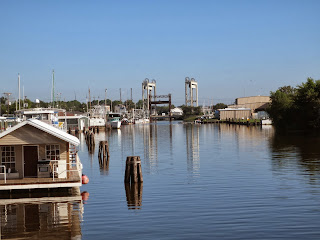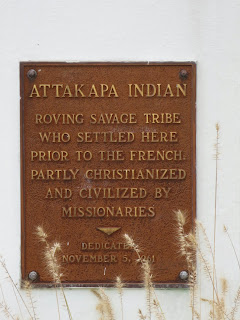The sun came up around 7.15am.
 These lovely shrimp boats are just opposite us. They looked all clean and lovely this morning. Amazing what a little sun does for ones attitude:)
These lovely shrimp boats are just opposite us. They looked all clean and lovely this morning. Amazing what a little sun does for ones attitude:)
Today had to be a chores day, as we were getting a bit low on t-shirts et al. As it had rained for the past three days since getting into the marina, we hadn't had that opportunity. Three loads of washing later, we were ready to depart for the day...but...
not before a trip into Abbeville to pick up some more plywood to fender boards. One of ours broke in the night...these shrimpers are not easy on the throttle when they pass us, and dont seem to even think that their wake might be destructive. We also got some glue (from Lowes) and a cookbook:) Well, you know how that goes, dont you? Lowes have a great variety of books and soft cover magazines for all kinds of things, at their entry, and it is usually my first port of call when we go there.
However, we went for the plywood, and they happily cut it into two for us at no extra charge. All waz has to do is drill some holes.
He is presently splicing rope to attached to the bottom end of our fenders so that we can hang them horizontally quickly and easily. Always something to think ahead of on a boat. We have some locks to go through in the near future, so we want to be prepared. This dock has also shown us that we are not quite as well prepared as we might be for docks that are not so hospitable. Though this is a new-ish marina, they did not have the casual boater in mind when they built this fixed dock.
Having made some savory muffins for our lunch...I had some Canadian bacon that looked like it was dying, so used that, some green onion and cheese in them...yummy:)...we went off in search of more History.
It appears we ventured into Creole territory...all the cafes in St Martinsville were offering Creole food, instead of Cajun...which is interesting, given that St Martinsville is the 6th settlement of Arcadiana.
First up, let me say that we have been through some severely economically depressed areas in our travels, but none as bad as where we went today.
 ...and across the street, literally...on the corner of Rue Evangeline....whole other story there...soon!
...and across the street, literally...on the corner of Rue Evangeline....whole other story there...soon! The small cemetery at the side of the church held some significant grave stones. This is one of them. I chose to photograph this because it is so beautiful
The small cemetery at the side of the church held some significant grave stones. This is one of them. I chose to photograph this because it is so beautiful My heart bleeds for the state of the this lovely old building. Alas, it is like so many others in this small town. There is just no money to refurbish them. There are so many significantly historical buildings in this town, it would take a fortune to rebuild.
My heart bleeds for the state of the this lovely old building. Alas, it is like so many others in this small town. There is just no money to refurbish them. There are so many significantly historical buildings in this town, it would take a fortune to rebuild.
The story of Evangeline
The idea for the poem came from Longfellow's friend, Nathaniel Hawthorne. Longfellow used dactylic hexameter, imitated from Greek and Latin classics, though the choice was criticized. It was published in 1847 and became Longfellow's most famous work in his lifetime. It remains one of his most popular and enduring works.
The poem had a powerful effect in defining both Acadian history and identity in the nineteenth and twentieth century. More recent scholarship has revealed the historical errors in the poem and the complexity of the Expulsion and those involved, which the poem ignores.
Here is another variation of the story....
Evangeline describes the betrothal of a fictional Acadian girl named Evangeline Bellefontaine to her beloved, Gabriel Lajeunesse, and their separation as the British deport the Acadians from Acadie in the Great Upheaval. The poem then follows Evangeline across the landscapes of America as she spends years in a search for him, at some times being near to Gabriel without realizing he was near. Finally she settles in Philadelphia and, as an old woman, works as a Sister of Mercy among the poor. While tending the dying during an epidemic she finds Gabriel among the sick, and he dies in her arms.
A little more background history on the Arcadians which might aid understanding...
The Expulsion was planned and executed by New Englanders and British. Longfellow omitted from the poem New England's responsibility for the event. Through his poem, Longfellow defines the British as responsible for the expulsion and America is cast as a place of refuge. This omission may explain in part why Americans were able to celebrate a poem that was based on a traumatic historic event for which they were significantly responsible. Longfellow's account was later challenged by Francis Parkman in his book Montcalm and Wolfe (1884). Rather than blaming the British, Parkman defined the real problem in expulsion as the French influence on Acadians, particularly by Abbe Jean-Louis Le Loutre. American historian John Brebner eventually wrote New England's Outpost (1927), which identified how instrumental New Englanders were in the expulsion of the Acadians.
The poem had a powerful impact in both defining Acadian history and identity in the nineteenth and twentieth century. More recent scholarship has revealed the historical errors in the poem and the complexity of the Expulsion and those involved, which the poem obscures. For example, Longfellow's poem renders Acadie a utopia and the Acadians as simply a homogeneous, passive, peaceful, innocent people while obscuring the resistance that certain Acadians demonstrated — both politically and militarily — against the British invasion of Acadie.
The poem also led generations of Protestant Anglophones to sympathize with the plight of a people whom they often demonized and persecuted for being Catholic. The poem also provided a safe symbolic space for Acadians to develop arguments for more recognition and respect.
in the cemetery outside the church
After leaving St Martinville, we came back to the boat just before the heavens opened. While taking in the laundry, this huge dragonfly flew onto the boat, and then, unfortunately it flew into the water, and there it remained. I was unable to fish it out:(
Time for me to get some dinner. It is 6.15pm, and we are hungry.
Tomorrow...more!















No comments:
Post a Comment